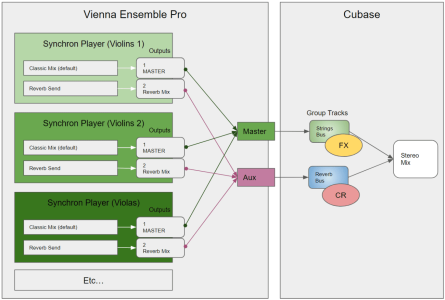blaggins
Senior Member
I've been using the Synchron libs as the main part of my "template" for a while now (WW, Brass, Percussion, and Duality Strings) but I feel a bit stuck on a mixing strategy. What I have been doing is working "ok" I think, but I'm wondering if there's a more optimal way to set things up and get better positioning and a better default sound. I realize there is a LOT that goes into getting a polished finished product, including effects, EQ, reverb, etc. and I'm curious what works for those of you that are also using Synchron libs as their default orchestral instruments. Anyone have a favorite FX chain or reverb strategy?
Here's what I pretty much always end up doing:
Within a VEPro Instance (say Strings)
* Set all the instruments to "Classic" or Surround-downmixed-to-stereo-Classic presets
* Turn off the Synchron Player Reverb but leave Reverb channel ENABLED in the Synchron player
* Route the Reverb channel in the Player to output 2
* Apply an instrument-specific EQ in VEPro (as needed), same EQ settings for both MASTER and AUX channels for each instrument
* Bus the various channels in VEPro into MASTER (all outputs 1) and AUX (all outputs 2)
Then in Cubase I have two Stereo inputs from each VEPro Instance which I bus separately. One bus (the main one, or the Strings bus from the diagram below) is where I put all my inserts (like a dynamic EQ, probably Gullfoss, maybe a bit of saturation, or a compressor for the Percussion, etc.) and the other channel which I'm called Reverb Bus in the diagram below is to collect all the "Reverb Mixes" and send them to an instance of Cinematic Rooms. This is basically my way of using my own reverb (CR) in place of the reverb that comes with the Synchron Player. My Reverb Bus is always 100% wet and the volume is very quiet compared to the Main Bus, it's really just there to add back in that extra signal you lose if you just turn off the Synchron Player reverb and also disable that channel in the player (for example, if you just turn it off, you are favoring the Room mics over a blended and reverb-ed mix of Close, Mid, and Room mics, since the room is never sent to the internal reverb, but Close and Mids usually are at varying levels).
I've created a quick little visual:

All that being said, I'm not messing with the mic levels per instrument in the Synchron Player, they all get set to the Classic mix defaults. I also don't try to mess with panning b/c I feel like I would be messing with the carefully crafted presets and would likely end up in a crappier place than I started. But I do feel like I might be leaving a lot of functionality on the "floor" as it were since there are so many mixer configs possible and so many provided presets that I never use.
Is it recommended to use different mixes as starting points to create depth? Say using Close, Classic, and Distant mixes on different instrument groups to create depth? Or is that a stupid idea?
Do folks find themselves changing the panning to create a wider soundstage? Anyone strongly preferring the Wide mix over the Classic one?
I would take any pointers that have been yielding good mixes from you fellow Synchron library users. Thanks so much!
Here's what I pretty much always end up doing:
Within a VEPro Instance (say Strings)
* Set all the instruments to "Classic" or Surround-downmixed-to-stereo-Classic presets
* Turn off the Synchron Player Reverb but leave Reverb channel ENABLED in the Synchron player
* Route the Reverb channel in the Player to output 2
* Apply an instrument-specific EQ in VEPro (as needed), same EQ settings for both MASTER and AUX channels for each instrument
* Bus the various channels in VEPro into MASTER (all outputs 1) and AUX (all outputs 2)
Then in Cubase I have two Stereo inputs from each VEPro Instance which I bus separately. One bus (the main one, or the Strings bus from the diagram below) is where I put all my inserts (like a dynamic EQ, probably Gullfoss, maybe a bit of saturation, or a compressor for the Percussion, etc.) and the other channel which I'm called Reverb Bus in the diagram below is to collect all the "Reverb Mixes" and send them to an instance of Cinematic Rooms. This is basically my way of using my own reverb (CR) in place of the reverb that comes with the Synchron Player. My Reverb Bus is always 100% wet and the volume is very quiet compared to the Main Bus, it's really just there to add back in that extra signal you lose if you just turn off the Synchron Player reverb and also disable that channel in the player (for example, if you just turn it off, you are favoring the Room mics over a blended and reverb-ed mix of Close, Mid, and Room mics, since the room is never sent to the internal reverb, but Close and Mids usually are at varying levels).
I've created a quick little visual:

All that being said, I'm not messing with the mic levels per instrument in the Synchron Player, they all get set to the Classic mix defaults. I also don't try to mess with panning b/c I feel like I would be messing with the carefully crafted presets and would likely end up in a crappier place than I started. But I do feel like I might be leaving a lot of functionality on the "floor" as it were since there are so many mixer configs possible and so many provided presets that I never use.
Is it recommended to use different mixes as starting points to create depth? Say using Close, Classic, and Distant mixes on different instrument groups to create depth? Or is that a stupid idea?
Do folks find themselves changing the panning to create a wider soundstage? Anyone strongly preferring the Wide mix over the Classic one?
I would take any pointers that have been yielding good mixes from you fellow Synchron library users. Thanks so much!


 while stock ones are good, I believe they surely can be even better. I also think most of them are pretty close and ambient ones are little undetailed. I like how Spitfire ready mixes sound in their libs, save time a lot and sound great out of the box.
while stock ones are good, I believe they surely can be even better. I also think most of them are pretty close and ambient ones are little undetailed. I like how Spitfire ready mixes sound in their libs, save time a lot and sound great out of the box.
